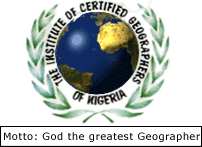ASSESSMENT OF THE IMPACT OF HIV /AIDS PREVENTIVE AWARENESS EFFORTS IN PARTS OF KADUNA METROPOLIS
Akwo, JS. fcg
Institute of Certified Geographers of Nigeria souzaonthemove@gmail.com
Onwuzuruike, NV. (RN)
Nigerian National Petroleum Corporation Med. Centre
Kaduna Refinery, Kaduna. 08036143068
ABSTRACT
Since the discovery of AIDS there has been effort put in place to mitigate the challenges posed by the disease in Nigeria. The efforts have been from government, NGOs and the international community. However according to this thesis the effort has not met the need of the general population in terms the awareness of the prevention of the disease, especially in parts of Kaduna metropolis. Four specific objectives were set for the work with corresponding research questions. The area of study covers parts of Kaduna South and Chikun LGA in the metropolis from which a population of 775,003, from which 120 households were sampled with a total of 668 respondents. The work adopted the qualitative and quantitative data gathering method with a structured questionnaire used as a means of gathering quantitative variables. The study found out that majority of the respondents were aware on some aspects of HIV/AIDS infection, transmission and prevention implying that awareness creation on infection with HIV/AIDS was necessary among them. However, in the areas of prevention that directly relates to sex, respondents are not adhering to the prevention and control of the disease. For example, a situation where 39% think withdrawing before orgasm would prevent HIV is alarming. The study also found that the testing rate of the health facilities in the study area does not commensurate the population of the area.
Key words: Awareness, Perception, HIV, AIDS
PERSPECTIVE ON BIODIVERSITY AND HUMAN ACTIVITIES DISRUPTING AND IMPAIRING THEIR EXISTANCE IN THE NORTH- EAST REGION OF NIGERIA
Yakubu Baba Ali 1 Department of Environmental Science Federal Polytechnic Mubi Adamawa State. Email- babaaliyakubu@gmail.com Phone No. 07033634463
Yakubu Garba 2 Department of Environmental Science Federal Polytechnic Mubi Adamawa State Email- gyakubu70@gmail.com
Maria Dingari 3 Department of Science Laboratory Technology Federal Polytechnic Mubi Adamawa State. Email- mariadingari@yahoo.com Phone No. 07064770148
ABSTRACT
Biodiversity in the north east region of Nigeria have been recognized for long due to its plant and animal species richness as well as its importance in terms of natural resource that support human livelihood through the provision of ecosystem services. However, little attention has been given to the evolutionary consequences or implications of human activities that fundamentally change the environmental features of the region. Anthropogenic activities such as agriculture, industrialization, pastoralism among others have caused the loss of adaptive biodiversity such as animals and plants in the sampled area of Adamawa and Yobe states as analyzed through the use of table to indicate animal and plant abundance (table 1). This was revealed through the use of observation and survey as instruments of data collection as well as through the assistance of indigenous residence that provided some of the information analyzed in this study. Persistent and unsustainable consumption of these biological resources have undoubtedly limited the ability of species to survive under unfavorable environmental condition with hundreds of animals and plants that were rarely or occasionally found in the region and this may lead to further loss of available species with long term effect on man survival. Therefore, the study recommended that there is the need for government and stakeholders to design a framework that will not only curtail human dangerous activities in the region, but also subject the culprits under legal procedure where appropriate punishments will be assigned. In conclusion, biodiversity is aggressively destroyed by man with little or no effort to avert the menace.
Key words: Biodiversity, Species, Animal, Plant, Environmental sustainability
SPATIO-TEMPORAL ANALYSES USING GEOGRAPHIC INFORMATION SYSTEM AND REMOTE SENSING TECHNIQUES – A CASE STUDY OF LAGOS METROPOLIS, LAGOS STATE, NIGERIA.
BALOGUN F.A, (Surv, FCG). OLOYEDE-KOSOKO S.O.A, ACG and ADETIMIRIN O.I, (ACG). DEPARTMENT OF GEOGRAPHIC INFORMATION SYSTEMS, FEDERAL SCHOOL OF SURVEYING, P.M.B. 1024. Oyo.
Abstract
The study of urban dynamics has been a herculean tasks, prior to this technology the use of photogrammetry and manual cartography has been the way out, but the use of remote sensing and GIS techniques in the spatio-temporal analyses has taken a new dimension both in 2D and 3D, showing what is taking place in the urban space and with ground truthing or not, we can know why those changes have taken place? This study focuses on the use of Remote Sensing and Geographic Information System in mapping urban growth and land use change detection of Lagos Metropolis between 1964 and 2015. Topographic maps of 1964, street map of 1999 were acquired, scanned and georeferenced. Satellite imagery of 2015 was downloaded from Google earth and together with the maps digitized to map urban area of Lagos metropolis for three different periods. Search and overlay operations were carried out to detect the extent of urban growth and land use change in the study area for the different periods. The results of this study show that the total built-up area has expanded tremendously between 1964 and 2015.
Keywords: Remote Sensing, Change detection, GIS, Mapping, and Temporal Analysis
EVALUATION OF CONTEMPORARY CHALLENGES OF PUBLIC PARTICIPATION IN ENVIRONMENTAL IMPACT ASSESSMENT IN YOLA NORTH L.G.A ADAMAWA STATE
Yakubu Baba Ali, ACG Department of Environmental Science Federal Polytechnic Mubi Adamawa State. Email- babaaliyakubu@gmail.com Phone No. 07033634463
Ignatius Joseph Department of Environmental Science Federal Polytechnic Mubi, Adamawa State. Email- josephignatius0@gmail.com Phone No. 07034209074
Jibir Audu Department of Urban and Regional Planning Federal Polytechnic Mubi Adamawa State. Phone No. 08030407098
Abstract
This study was carried out among residents of Jimeta town, with the aim of evaluating people’s perception on contemporary challenges influencing public participation in EIA process. Sixty respondents (twenty in each ward) were sampled from three wards of Doubeli, Gwadabawa and Jambutu in Jimeta town for the purpose of this study. Data were analyzed using descriptive statistics of table of frequency and percentage. The study revealed that public participation in EIA process was relatively affected by factors mentioned in this study (table 1.2), which consequently has its effect on the environment. Results from this study also revealed that members of the public were only allowed occasionally by government officials to participate in EIA process in order not to hinder the success of a project. These factors have made the study area to be vulnerable to environmental problems which may have serious effect on the people in the nearest future if not averted. It is recommended that ministry of environment and stakeholders should strengthen and implement policies that will improve public participation in EIA process. In conclusion, developers should recognize and incorporate members of the public at all stages of any development project with the aim of promoting environmental management and economic growth.
Keywords: EIA, Contemporary, Challenges, Participation, environment.
CONCEPTUAL FRAMEWORK FOR DESIGNING A SPATIAL DATABASE AND MODELING LANDUSE INFORMATION IN THE FEDERAL CAPITAL TERRITORY ABUJA, NIGERIA.
Maisamari I.J, ACG; Forestry Technology Department, Federal College of Forestry Mech. Afaka, Kaduna State. Email: isaacmaisamari@gmail.com
abstract
The research problem focuses on applying GIS as a potential tool in database design and creation. Yet with the recent development in computing, a dearth of data and poor geo-database exist with most land use studies being largely limited to mapping operations. Till date, the population in the FCT has grown at a phenomenal rate over a relatively short period of time. This has thus affected most land use patterns thereby making it the fastest growing city in the country today. Noteworthy is the vital issue on land availability is thus becoming tremendous in studying land use patterns due to their exerting pressure and is today one of the most important global issues particularly within the paradigms of sustainable development. In order to resolve the research problem, the study is therefore expounded on in terms of motivating an investigation of spatial and modeling concepts in database design for effective land use assessment studies. Thus, the noble objective is to be able to provide a strong information on land use patterns, develop robust spatial databases in a timely and cost effective manner and augment non-existing GIS databases that can be centralized, made accessible to all user agencies in order to avoid duplication of effort and help maximize efficiency in data management. Hence, the present findings will be more abundant and instructive.
Keywords: Land use, GIS, Remote Sensing, Spatial Concepts, Data Models and Database design
LIVELIHOOD ACTIVITIES AND FOREST RESOURCES EXPLOITATION IN AKAMKPA, NIGERIA
1Arikpo, I. Abam; 2Williams, J. J, ACG; 3Boni P. G; 4Teru C. P. 1Department of Geography, School of Environmental Sciences, Modibbo Adama University of Technology,’, Yola. 2Adamawa State College of Education, Hong, Nigeria. 3Adamawa State College of Agriculture, Ganye. 4Adamawa State College of Agriculture, Ganye.
Abstract
The study examined livelihood activities and forest resource exploitation in Akampa Local Government Area of Cross River State Nigeria. Five (5) communities were selected for the study using the tie and draw method. The communities have a total population of 4803 people, which constitutes the study population; stage wise sampling was adopted to select the study sample, such that from each village, only 10% of the population forms the sample size. The study used two data sets; these are the respondent socio- economic characteristics and data for assessing the livelihood activities in the study area. The data for the study were gathered through the administration of structured questionnaire to the respondents. Data generated from the field was analyzed using simple percentage and chi-square was employed to analyzed livelihood activities of the forest activities. The finding shows that there are relatively active young men/women who exploit the forest for income generation, and these results to higher forest exploitation. The findings also indicated that large populations of the respondents are farmers who engage in farming activities that results to forest degradation. The study further revealed that the most dominant livelihood activities in the study area are farming, wood carving/local crafts and sale of timber etc. It is hereby recommended that government should make adequate policies that should be in agreement with the needs and aspiration of the forest communities.
Key words: Forest Resources, Livelihood, Poverty, Poaching
DOWNLOAD JOURNAL


